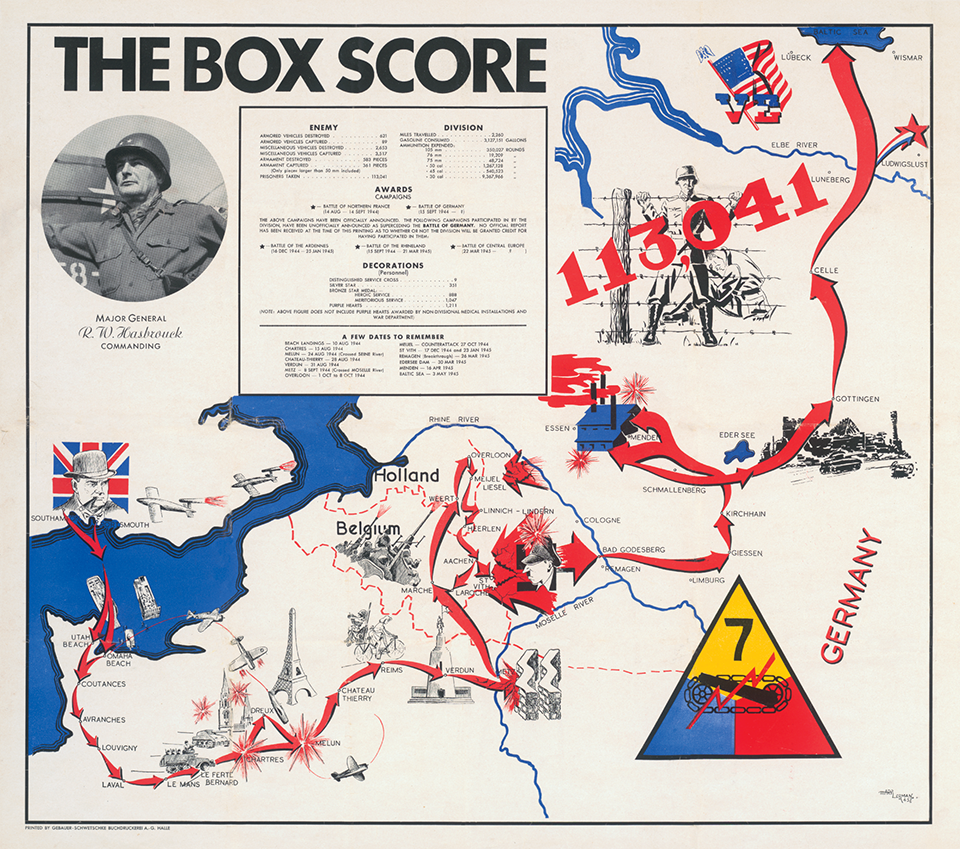7th Armored DIVISION - Lucky 7th
Activated 1 Mar 1942 • Entered Combat 14 Aug 1944 at Northern France• Days of Combat 172 • Casualties 5,799
Commanding General
Maj. Gen. Lindsay McD. Silvester (Mar 42 - Nov 44)
Maj. Gen. Robert W. Hasbrouck (Nov 44 - Aug 45)
Brig. Gen. Truman E. Boudinot (Sep 45 - inactivation)
Campaigns
Northern France (25 Jul 44 - 14 Sep 44)
Rhineland (15 Sep 44 - 21 Mar 45)
Ardennes-Alsace (16 Dec 44 - 25 Jan 45)
Central Europe (22 Mar 45 - 11 May 45)
This campaign map shows the route of the 7th Armored Division during World War II. This chart is available for purchase at HistoryShots.com.
Division Chronicle
The Division landed on Omaha and Utah Beaches, 13-14 August 1944, and drove through Nogent-le-Rotrou in an attack on Chartres. The city fell on 18 August. From Chartres the Division advanced to capture Dreux, Melun, and Chateau-Thierry, crossed the Seine River, 24 August, and pushed on to take Verdun, 31 August. The 7th halted briefly for refueling and then drove on toward the Moselle near Dornot. The Division was repulsed in its attacks across the Seille River. The 7th then shifted to Holland, where on 8 October it joined in defensive operations protecting the British-Canadian drive to clear the northern and western approaches to Antwerp. After resting during November, the Division returned to the front near Linnich, Germany, on the banks of the Roer. It was preparing to drive into Germany when the Von Rundstedt winter offensive began on 16 December 1944. The Division was ordered to St. Vith where it absorbed much of the weight of the German drive and was forced to withdraw west of the Salm River, 23 December. It shifted to Manhay, Belgium, and by the end of December had cleared the town of the enemy. After a brief rest in January 1945, the Division returned to positions near St. Vith, attacked, and captured the town. February and part of March were spent in rest and rehabilitation. In March 1945 the Division held defensive positions along the west bank of the Rhine, south of Bonn to Unkelbach. The 7th returned to the offensive on 26 March, breaking out of the Remagen bridgehead, and took part in the reduction of the Ruhr Pocket. On 16 April the 53d German Panzer Corps surrendered to the Division and the eastern sector of the pocket collapsed. The Division then cut across the Elbe and swept north into Mecklenburg, effecting a junction with the Russians as the war in Europe ended.
Date Activated is the date the division was activated or inducted into federal service (national guard units).
Casualties are number of killed, wounded in action, captured, and missing.
The dates after the campaign name are the dates of the campaign not of the division.
The Army Almanac: A Book of Facts Concerning the Army of the United States; , U.S. Government Printing Office. Army Battle Casualties and Nonbattle Deaths in World War II, Final Report, 1 December 1941 - 31 December 1946. US Army Center of Military History at http://www.history.army.mil/ Various divisional histories


